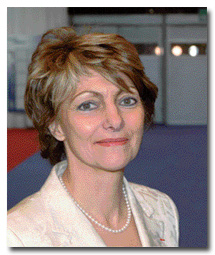Frédérique Mutel is president and CEO of JEC Group, the Paris-based organization representing the
composites industry. She joined JEC in 1997 and has largely been responsible for its expansion into
a global entity with the leading industry trade shows and conferences in Europe, Asia and North
America as well as the industry’s most widely read industry publication, “JEC Composites.”
Mutel is the recipient of several prestigious awards and honors including the Legion of Honor
in 1999 for her contribution to providing opportunities and forums for international exchanges. Her
career has included development projects at the U.S. Department of State’s Agency for International
Development. She has also held positions in the information technology and publishing sectors.
Textile World: Tell us briefly about JEC Group. How is it structured? Who does it
represent? What is the scope of the organization? What is its mission?
Mutel: JEC represents, promotes and expands composites markets by providing global
or local networking and information services. JEC Group belongs to a nonprofit association created
in 1956 that holds the capital. JEC’s Board of Directors includes heads of companies from different
industry segments. Our philosophy is to serve the composites sector. All of JEC’s income is used
for the benefit of the industry. JEC aims to be close to the sector and proactive in its proposals.
TW: Can you tell us more about the global composites industry?
Mutel: The global composites market represents 81.6 billion euros (US$108.9
billion) in value and 9.2 million metric tons in volume for 2012. This market is growing at an
average of 6 percent per year. In value, the Americas represent 36 percent; Europe, 33 percent; and
Asia Pacific, 31 percent. The composites industry is growing in volume in correlation with the
increase of gross domestic product by country. In mature economies, composites’ positions against
other materials are stable or still growing, especially in markets where lightness is strongly
required, as in transportation — aero, auto, marine and land. In emerging countries, the composites
market is mainly driven by economic growth following the development curve. There, the potential is
huge in all sectors.
TW: Tell us about the upcoming JEC Europe Composites Show & Conferences. Will
it be of interest to those in the mainstream of the technical textiles industry?
Mutel: With 50,000 square meters, or 530,000 square feet, of floor space — the
equivalent of eight soccer fields — the 2013 JEC Europe Composites Show & Conferences will
represent the global composites industry and its most recent advances in heavily
composite-consuming sectors such as aerospace, aeronautics, shipbuilding, railway, automotive, mass
transportation, construction, equipment, and sports and leisure. Twelve key themes will be
highlighted during the three-day trade show: Design, Non-Destructive Testing, Robotics,
Aeronautics, Automotive, E-car, Wind Power, Carbon, Biocomposites, Thermoplastics, Multifunctional
Materials and Environment. Our participants largely represent the upstream of the value chain — for
example, fibers and equipment, with many solutions in new fibers, new formulations and new
polymers. Producers of fabrics and pregregs alsoare among JEC’s main customers.

Frédérique Mutel, president and CEO, JEC Group
TW: A couple of years ago, you launched the JEC Asia C
omposites S
how & Conferences, and this past November, you held your inaugural JEC Americas Composites
Show & Conferences. Why are y
ou organizing these shows?
Mutel: Our policy is to reinvest all revenues into developing new products and
services for the composites sector. JEC is pursuing its mission to inform and provide technical
training for composites professionals by regularly launching new publications and setting up an
e-store to sell them online. JEC allocates major human and financial resources to research and
studies of application markets. The group also devotes significant funding to creating programs to
boost innovation and foster connections among science, technology and business — such as business
meetings, seminars and conferences, and exhibitions. More and more customers are global and require
having global suppliers. The JEC network now accompanies them in North America, Europe and Asia.
Our brand guarantees the same level of high quality everywhere, and customers enjoy finding the
same service adapted to the local market, of course.
TW: Did the recent North America show meet your expectations?
Mutel: There were 306 exhibiting companies — 65 percent from North America and 35
percent from Europe and Asia — and 6,698 attendees, with 4,159 professional visitors from 53
countries and 36 states attending, clearly confirming the interest of the international composites
industry in the Americas market. These good results are all the more positive, as the show suffered
from many last-minute attendance cancellations due to a major winter storm that hit New England on
the second day.
TW: In the future, do you plan to go it alone with JEC Americas or find a
colocation partner like you did in 2012 with the Industrial Fabrics Association International? You
have already announced dates for 2013 and 2014, both again to be held in Boston. Why do you plan to
stay in Boston?
Mutel: JEC has a long tradition of cooperation and networking. Colocation with
events that bring additional value to our mutual audience is a good way to enlarge the vision and
perception of composites materials. Our first session in Boston was successful and encourages us to
reinforce our position in this area close to the academic community, research and development
centers and very dynamic states. A good number of our customers are located in the Northeast United
States. Canada is also very active in the field of composites.
TW: What new technologies, materials or composite applications do you see
coming?
Mutel: Our sector is innovative all along the value chains for both materials and
processes. Concerning fibers, innovation has come from an increase in mechanical properties such as
fiber stiffness and resistance. Price has also been a path for innovation, as the challenge for raw
material suppliers is the development of superior products with the concern of keeping price within
a reasonable range. Semi-products and technical fabrics have been a major driver of growth in
composite use. Resin manufacturers have explored two major solutions to cope with the issue of
styrene. The first is to develop new resins with minimum styrene content. The second is to focus on
styrene suppressant additives that limit the emission itself. Concerning fire and smoke toxicity,
the challenge has been to develop composite materials that are altogether less flammable; have
lower smoke emissions with little toxicity; and can keep reasonable mechanical properties after
fire damage. Environmental concern takes a growing importance in the industry. Resins and additives
are petrochemical materials that use nonrenewable resources and energy for their production. Over
the last decade, major resin and additive manufacturers have developed an eco-friendly range of
bioproducts derived from vegetal sources.
For applications that do not require high-resistance materials, natural fibers can be very
efficient. They tend to be more and more important in the automobile manufacturing industry — for
instance, for nonstructural parts like car interiors.
Finally, a huge amount of innovation is taking place in the field of process and equipment.
Soaring development of composites demand has driven the need for higher productivity and industrial
pace. As a consequence, there has been a strong need to evolve the composite process, and recent
innovations in the field of robotics and automation have come as an appropriate answer to tackle
this issue. One-third of our portfolio is now composed of industrialists proposing new equipment,
machines or software.
Stephen M. Warner is publisher of BeaverLake6 Report,
beaverlake6.com, a Web-based newsletter reporting on
trends, data and issues that he feels influence the technical textiles industry. He also is former
president and CEO of Industrial Fabrics Association International.
January/February 2013




